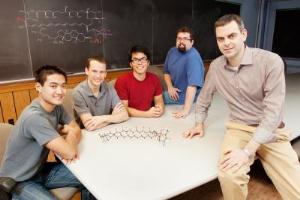

CHAMPAIGN, Ill. - With one simple experiment, University of Illinois chemists have debunked a widely held misconception about an often-prescribed drug.
Led by chemistry professor and Howard Hughes Medical Institute early career scientist Martin Burke, the researchers demonstrated that the top drug for treating systemic fungal infections works by simply binding to a lipid molecule essential to yeast's physiology, a finding that could change the direction of drug development endeavors and could lead to better treatment not only for microbial infections but also for diseases caused by ion channel deficiencies.
"Dr. Burke's elegant approach to synthesizing amphotericin B, which has been used extensively as an antifungal for more than 50 years, has now allowed him to expose its elusive mode of action," said Miles Fabian, who oversees medicinal chemistry research grants at the National Institute of General Medical Sciences. The institute is part of the National Institutes of Health, which supported the work. "This work opens up avenues for improving upon current antifungals and developing novel approaches for the discovery of new agents."
Systemic fungal infections are a problem worldwide and affect patients whose immune systems have been compromised, such as the elderly, patients treated with chemotherapy or dialysis, and those with HIV or other immune disorders. A drug called amphotericin (pronounced AM-foe-TARE-uh-sin) has been medicine's best defense against fungal infections since its discovery in the 1950s. It effectively kills a broad spectrum of pathogenic fungi and yeast, and has eluded the resistance that has dogged other antibiotics despite its long history of use.
The downside? Amphotericin is highly toxic.
"When I was in my medical rotations, we called it 'ampho-terrible,' because it's an awful medicine for patients," said Burke, who has an M.D. in addition to a Ph.D. "But its capacity to form ion channels is fascinating. So my group asked, could we make it a better drug by making a derivative that's less toxic but still powerful? And what could it teach us about avoiding resistance in clinical medicine and possibly even replacing missing ion channels with small molecules? All of this depends upon understanding how it works, but up until now, it's been very enigmatic."
While amphotericin's efficacy is clear, the reasons for its remarkable infection-fighting ability remained uncertain. Doctors and researchers do know that amphotericin creates ion channels that permeate the cell membrane. Physicians have long assumed that this was the mechanism that killed the infection, and possibly the patient's cells as well. This widely accepted dogma appears in many scientific publications and textbooks.
However, several studies have shown that channel formation alone may not be the killing stroke. In fact, as Burke's group discovered, the mechanism is much simpler.
Amphotericin binds to a lipid molecule called ergosterol, prevalent in fungus and yeast cells, as the first step in forming the complexes that make ion channels. But Burke's group found that, to kill a cell, the drug doesn't need to create ion channels at all - it simply needs to bind up the cell's ergosterol.
Burke's group produced a derivative of amphotericin using a molecule synthesis method Burke pioneered called iterative cross-coupling (ICC), a way of building designer molecules using simple chemical "building blocks" called MIDA boronates joined together by one simple reaction. They created a derivative that could bind ergosterol but could not form ion channels, and tested it against the original amphotericin.
If the widely accepted model was true, and ion channel formation was the drug's primary antifungal action, then the derivative would not be able to wipe out a yeast colony. But the ergosterol-binding, non-channel-forming derivative was almost equally potent to natural amphotericin against both of the yeast cell lines the researchers tested, once of which is highly pathogenic in humans. The researchers detailed their findings in the journal Proceedings of the National Academy of Sciences.
"The results are all consistent with the same conclusion: In contrast to half a century of prior study and the textbook-classic model, amphotericin kills yeast by simply binding ergosterol," Burke said.
"The beauty is, because we now know this is the key mechanism, we can focus squarely on that goal. Now we can start to think about drug discovery programs targeting lipid binding."
The researchers currently are working to synthesize a derivative that will bind to ergosterol in yeast cells, but will not bind to cholesterol in human cells, to see if that could kill an infection without harming the patient. They also hope to explore other derivatives that would target lipids in fungi, bacteria and other microbes that are not present in human cells. Attacking these lipids could be a therapeutic strategy that may defy resistance.
In addition to exploiting amphotericin's lipid-binding properties for antimicrobial drugs, Burke and his group hope to harness its channel-creating ability to develop treatments for conditions caused by ion-channel deficiencies; for example, cystic fibrosis. These new findings suggest that the ion-channel mechanism could be decoupled from the cell-killing mechanism, thus enabling development of derivatives that could serve as "molecular prosthetics," replacing missing proteins in cell membranes with small-molecule surrogates.
"Now we have a road map to take ampho-terrible and turn it into ampho-terrific," Burke said.
Further Information:
Kaitlyn C. Gray, Daniel S. Palacios, Ian Dailey, Matthew M. Endo, Brice E. Uno, Brandon C. Wilcock, and Martin D. Burke:
Amphotericin primarily kills yeast by simply binding ergosterol.
In: Proceedings of the National Academy of Sciences; PNAS, published online before print January 17, 2012, DOI 10.1073/pnas.1117280109
Source: University of Illinois at Urbana-Champaign
Last update: 17.01.2012
Perma link: https://www.internetchemistry.com/news/2012/jan12/amphotericin-b.php
More chemistry: index | chemicals | lab equipment | job vacancies | sitemap
Internetchemistry: home | about | contact | imprint | privacy
© 1996 - 2023 Internetchemistry
